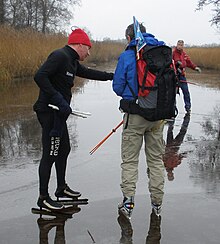User:Ddermott/skating/old
| This is not a Wikipedia article: It is an individual user's work-in-progress page, and may be incomplete and/or unreliable. For guidance on developing this draft, see Wikipedia:So you made a userspace draft. Find sources: Google (books · news · scholar · free images · WP refs) · FENS · JSTOR · TWL |
Tour Skating
[edit]
Tour skating is a recreational form of long distance ice skating on natural ice. The Nordic style of Tour skating, often called Nordic Skating or Trip skating, is popular in the Nordic Countries, especially Sweden, but increasingly in Finland and Norway.
With this style of skating, the condition of the ice surface and the ice strength is not known beforehand, so the skaters have to check this as they proceed. These skaters chose their own track in order to find scenic views, smooth ice suface, tail winds etc. This requires that the skaters carry the safety equipment listed below, and have the knowledge of how to judge the ice.
Another style of Tour Skating, called Toerschaatsen, is very popular in the Netherlands, although the climate limits the availability of natural ice. The Netherlands is also the home of Elfstedentocht, a 200 km distance skating race. Long distance races are also organized annually in the Nordic countries, such as Vikingarännet in Sweden.
Nordic Tour Skating Equipment
[edit]
Tour skates consist of a circa 50cm long blade. They are attached, with bindings, to specialized boots (similar to walking boots) or cross country skiing boots - often with a free heel. Since tour skating often involves walking between lakes or around unskateable sections, the fact that the blades can be easily removed from one's boots is an asset.
In addition the following safety equipment is often recommended:

- ice prods or ice claws - a pair of metal spikes with handles (like sharpened screwdrivers) for hauling yourself out of holes in the ice
- ice pike or hansa pole - a pole with a metal spike (like a particularly sturdy ski pole) used to test the ice thickness
- throwing line - a rope to be pulled out of the water by
- rucksack with waistband and groin strap, containing change clothes in plastic bags. This also acts as a buoyancy aid.
Knee and elbow pads and a helmet are also commonly used.
Season
[edit]In late autumn/early winter the small lakes freeze first, sometimes as early as October. If snow falls these lakes can become unskateable. Next the somewhat larger lakes freeze and become skateable.
In January-February parts of the archipelago in the Baltic sea often freeze. This is the time when long skating tours can be undertaken. Tours of 60-80 km in one day are not uncommon - some skate over 150 km.
Safety
[edit]Tours should never be undertaken alone. An experienced skater with good knowledge of natural ice should always be present. The safety equipment listed above should be carried by all skaters.
If skateable ice is found in April (which is common in Sweden and Finland), it is advisable to skate in the morning only. If the night has been clear and cold the ice can be quite safe in the morning but deadly in the afternoon.
Associations
[edit]Sweden's largest tour skating association is The Stockholm Ice Skate Sailing and Touring Club (SSSK). Finland's largest tour skating association is Finland's Tour Skaters(in Swedish and Finnish)
There is a list of tour skating clubs in Sweden, Finland and Netherlands at Skridsko Net(in Swedish)
Toerschaatsen: Tour Skating in the Netherlands
[edit]
In the Netherlands, the style of Tour skating is called Toerschaatsen, where skaters follow marked routes on frozen canals and lakes, which are coordinated by the Royal Netherlands Skating Union,KNSB(in Dutch). [1] [2] The skaters mostly use common speed skates, with blades rigidly attached to the skating shoes. Ice-poles and other safety equipment are normally not carried.
Skate tracks on natural ice are taken care by the towns and communities,
which take care of the safety of the tracks. Safety matters should be
always taken seriously when skating on the natural ice.


